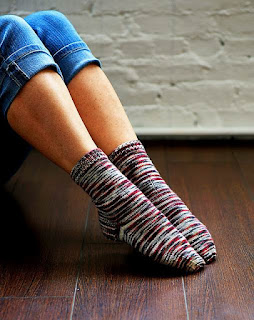Who taught you to knit?
My grandmother, Hilda Lowe. Hilda was a
life-long knitter. I don’t really remember learning to knit, just that I used to
do it at her side. I suspect I learned by osmosis!
What knitting method do you use? Continental?
English? Or...?
Predominantly an English knitter, but I work
Fair Isle two-handed, and when confronted with large swathes of garter stitch,
will often switch over to Continental.
What is your favourite stitch pattern?
I love tricky lace patterns – the more
complicated the better.
Why do you enjoy working Fair Isle
knits?
It’s like colouring for grown-ups!
What is your favourite yarn?
I have a soft spot for mohair. I love it in
sock yarns because it’s so very very warm (and my feet are very very cold), and
I love the big fluffy puffy colourful chunky weight mohair.
Is there a needle size that you prefer? Bamboo,
plastic or steel needles?
I’m a sock knitter: my favourite needles are my
6 inch 2.5mm Signature DPNs.
What is your favourite item to knit?
As above: socks. If I want something comforting
and easy, it’s a stocking stitch sock in a self-striping yarn all the way. If I
want something toothy, I love complicated socks: cables, lace, colorwork. I do a
lot of knitting out of the house: on public transport, in pubs and restaurants,
as a passenger in the car, and socks are very portable.
Where is your favourite place to knit?
Two places: Sitting on the sofa in our
basement, the dog snuggled between me and my hubby, watching something good on
TV, with a cup of tea at hand. My second favourite place to knit is the
streetcar: I have a long commute to one of my regular teaching gigs, and I
enjoy very much getting a window seat, listening to music on my headphones,
knitting away and enjoying the view as the city goes by. The first is comfier,
but the second location has better light!
What are you currently working on?
I’m working on a set of lace sock and
fingerless mitt designs... very excited about them!
Why did you become a knitwear
designer?
Because I have small feet. I bought Nancy
Bush’s seminal book Folk Socks when it was first published in the late 1990s.
Ms. Bush generally only provides one size for a sock pattern, and I found myself
needing to make alterations to the patterns to ensure they fit. Here I am, 15
years later, resizing socks for a living!
Tell me about your first pattern.
I’m not sure I remember my first... I’ve been
teaching for over 10 years, and I started designing patterns for sale at the
stores I teach at. One of my earliest patterns was a Santa Hat, which I still
love.
Where did it appear--on your website, in a magazine
or ezine?
For the first few years, I published patterns
only for sale in the stores I taught at; it wasn’t until Spring 2005 issue of Knitty that I had anything published to a broader audience. My first Knitty
article was ‘Socks 101’. I’ve published a number of articles and designs in
Knitty and other magazines since then, including Interweave Sockupied, Creative Knitting and others – and written my own book!
(For details about Kate's book--including a buy link--please scroll down to the bottom of this post.)
Do you attend fibre festivals?
Living in Toronto, I’m lucky enough to have
access to two excellent festivals close by: the Toronto Downtown Knit Collective
Knitter’s Frolic in the spring, and the Kitchener Waterloo Knitter’s Guide
Knitter’s Fair in the fall. They are both excellent places to see, fondle and
purchase knitterly goodies. I’ve also been attending Rhinebeck recently – an
incredible event.
Have you taught knitting classes? Where?
When?
All the time. I teach five or six times a week
at stores, events, conferences and fibre festivals. This fall alone I’ve got a
full schedule in Toronto area stores, and I’m off to teach at Toronto’s Creativ
(*yes, it is spelled like that*) Festival, at Vancouver’s Knit Social Event, at
Vogue Knitting Live in Chicago, and Interweave KnitLab in San Mateo. I love
teaching, and I believe strongly that it’s made me a better designer and pattern
editor. Talking to knitters of all experience levels every day shows me what
knitters want to knit, and teaches me what knitters enjoy, what they struggle
with, and what they want to do.
What is the most rewarding aspect about being a
knitwear designer?
That I’m doing what I love.
Challenging?
Creativity is challenging; I have to remind
myself often that the work itself is difficult. Designing is a process of trial
and error: sketch, swatch, knit, examine, adjust and repeat until you have what
you want. The initial idea can be easy: refining it to be something wonderful
is the challenging – but very rewarding part.
Blurb: Beyond Knit and Purl is designed to be the book that takes you from being confident about your needles to being confident about patterns.









